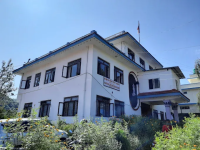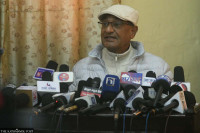National
Quarantine centres are turning into Covid breeding ground, National Human Rights Commission warns
Government ignoring repeated calls to improve situation in quarantine facilities, says its monitoring report..jpg&w=900&height=601)
Binod Ghimire
The government has completely failed to manage quarantine centres and they increase the risk of transmission of the disease rather than preventing it, the National Human Rights Commission said.
The constitutional body, in its report on the situation of human rights during the lockdown imposed to contain the spread of the disease, said quarantines centres that hold around 170,000 at present are turning into hotspots for the spread of the disease as the centres don’t meet minimum standards, and there haven’t been any visible effort to maintain WHO standards.
“A majority of the quarantine centres run the risk of spreading Covid-19,” said Anup Raj Sharma, chairperson of the commission, during a webinar organised to unveil the report prepared by a monitoring team that included members from Nepal Bar Association, Federation of Nepal Journalists and NGO Federation Nepal.
According to the WHO standards, those who are in quarantine must be placed in adequately ventilated, spacious single rooms with hand hygiene and toilet facilities. If single rooms are not available, beds should be placed at least one metre apart, it says.
“The government has been ignoring our repeated calls to improve quarantine facilities,” said Sharma.
Along with the commission, opposition parties have also been demanding the government pay attention to better manage quarantines. The government, however, has been saying that ensuring proper quarantine facilities for returnees from India and other countries is in its top priority.
Speaking at a meeting of the Lower House on Wednesday, Prime Minister KP Sharma Oli said the government was doing its bit to manage the 3,700 centres across the nation. He claimed the quarantine centres cand still accommodate thousands of returnees.
The monitoring report says despite evidence that rapid diagnostic tests (RDT) tests aren’t effective in detecting coronavirus, the government is still using them.
Govind Sharma Poudyal, a member of the commission who led the monitoring committee, said it is disappointing that the polymerase chain reaction (PCR) tests are being done in a sluggish manner. He said that over 10,000 tests are needed per day, but only 4,000 tests are being done. “The number of infections is increasing geometrically, but the government’s response is nowhere close to containing it,” he said.
The government had adequate time to prepare for the outbreak, but it didn’t, said the monitoring report. The first Covid-19 case was reported in Nepal on January 23 and it was only after two months that the number of cases surged to double digits. However, the government, so far, hardly has an installed capacity to examine around 5,000 samples per day, the authors of the report said.
The report lists around two dozen suggestions for the government asking it to ensure social distancing when the lockdown is lifted. It has also called on authorities to take prompt measures to improve quarantine facilities and tighten border control so that people don’t enter without permission.
It has suggested that all Nepali citizens willing to return home be repatriated. “It is very important that three tiers of government coordinate in their response to Covid-19,” reads one of the suggestions.




 18.12°C Kathmandu
18.12°C Kathmandu













%20(1).jpg&w=300&height=200)

